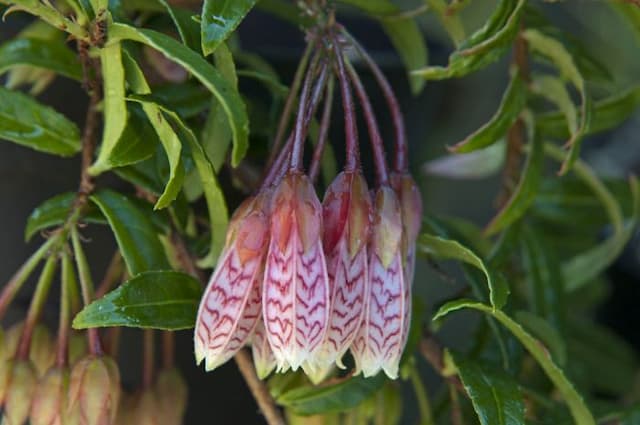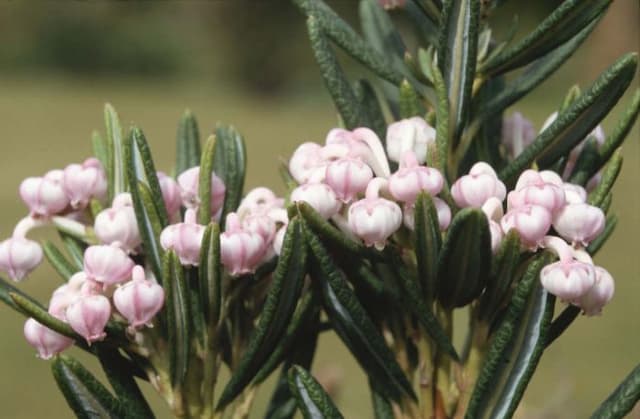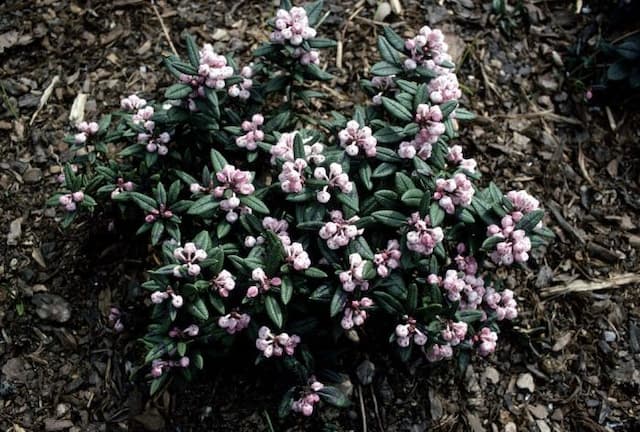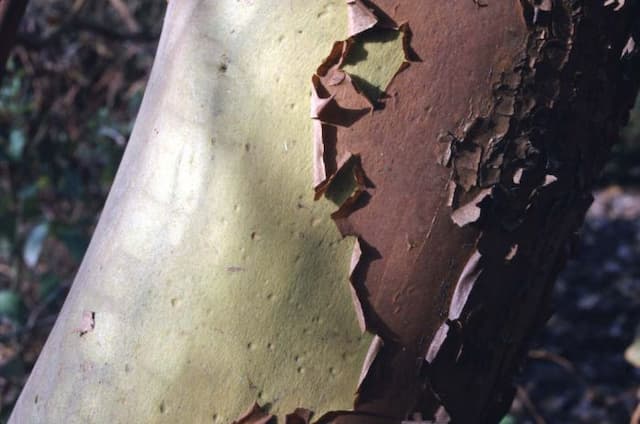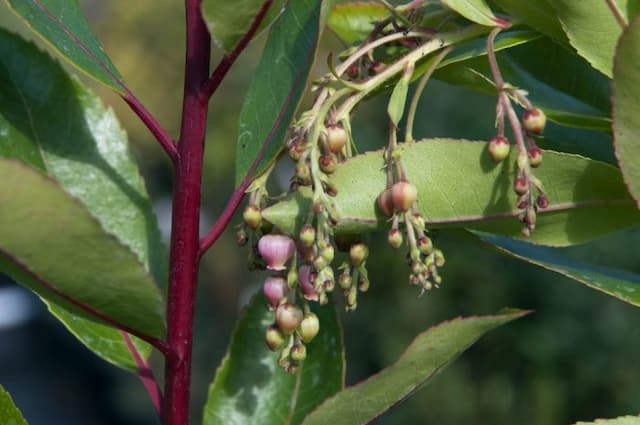Darley Dale Heath Erica × darleyensis f. albiflora 'Bing'

ABOUT
The plant known as 'Bing' is a particular variety that showcases a charming appearance marked by its evergreen foliage and prolific flowering habit. It typically bears small, needle-like leaves that are arranged densely along its branches, creating a fine, bushy texture. The leaves are often a deep, rich green that provides a lush backdrop for the blossoms. The flowers of the 'Bing' variety are particularly striking, as they emerge in clusters at the tips of the branches. They are characterized by their bell-shaped form and delicate petals which can be appreciated up close. In this specific form, the flowers are white, imparting a soft, snowy effect to the plant when it is in full bloom. These blooms typically appear in abundance, giving the plant a very festive and frothy appearance that can brighten up the space it occupies. This variety of the plant is hardy and versatile, adapting to a range of conditions while maintaining its ornamental appeal throughout the seasons. The combination of its appealing green foliage and the profuse white flowers make it a popular choice for gardens where a touch of elegance and charm is desired.
About this plant
 Names
NamesFamily
Ericaceae.
Synonyms
Darley Dale Heath, Mediterrean Pink Heath.
Common names
Erica × darleyensis f. albiflora 'Bing'.
 Toxicity
ToxicityTo humans
Darley Dale heath is generally considered non-toxic to humans, and there are no well-documented cases of poisoning from ingesting it. Consequently, there are no specific symptoms associated with Darley Dale heath poisoning in humans to describe, as it is not known to cause any.
To pets
Darley Dale heath is generally not listed as a toxic plant to pets, and there have not been significant reports of it causing poisoning in domestic animals such as cats and dogs. Therefore, there are no specific symptoms of Darley Dale heath poisoning to describe for pets, implying that ingestion of this plant is unlikely to lead to serious consequences for them.
 Characteristics
CharacteristicsLife cycle
Perennials
Foliage type
Evergreen
Color of leaves
Dark green
Flower color
White
Height
2 feet (60 cm)
Spread
3 feet (90 cm)
Plant type
Shrub
Hardiness zones
7
Native area
Europe
Benefits
 General Benefits
General Benefits- Low Maintenance: Requires minimal care once established, making it ideal for gardeners with limited time.
- Drought Tolerant: Can survive in dry conditions, reducing the need for frequent watering.
- Winter Interest: Provides color and structure to gardens during the colder months when other plants may not thrive.
- Attracts Wildlife: Flowers can attract pollinators such as bees and butterflies, promoting biodiversity.
- Ground Cover: Its spreading habit can cover ground quickly, suppressing weeds and reducing soil erosion.
- Year-Round Foliage: Evergreen leaves ensure the garden stays green throughout the year.
- Adaptable: It can grow in a range of soil types, although it prefers well-drained, acidic soil.
- Hardy: Resilient to many common pests and diseases, requiring less intervention and treatment.
- Decorative: The white flowers and evergreen foliage provide aesthetic value to gardens and landscapes.
- Compact Size: Its relatively small size makes it suitable for container gardening or smaller spaces.
 Medical Properties
Medical PropertiesThis plant is not used for medical purposes.
 Air-purifying Qualities
Air-purifying QualitiesThis plant is not specifically known for air purifying qualities.
 Other Uses
Other Uses- Photography Backdrops: The bright white flowers of the Darley Heath can provide a beautiful, natural background for macro photography or close-up shots of insects and other small wildlife.
- Artistic Inspiration: Artists can use the intricate patterns of Darley Heath's flowers and foliage as inspiration for paintings, drawings, and textile designs.
- Bee Garden Attraction: With its flowers, Darley Heath can be used to attract bees to the garden, supporting local pollinator populations.
- Frost Awareness: Given its blooming period, Darley Heath can serve as a natural indicator of the last frost dates for gardeners.
- Drought-Tolerant Landscaping: Darley Heath is suitable for xeriscaping, helping reduce water usage in gardens and landscaping.
- Educational Tool: Darley Heath can be used in schools or educational programs to teach children about plant biology and hybridization.
- Winter Gardens: The plant can enliven winter gardens, giving a splash of color during the colder, darker months.
- Erosion Control: Planted on slopes, Darley Heath can help in stabilizing the soil and preventing erosion.
- Living Mulch: The dense growth habit of Darley Heath can be used to suppress weeds and retain soil moisture.
- Culinary Garnish: Although not commonly known as an edible plant, the blooms can be used as a visually appealing, non-toxic garnish for culinary presentation.
Interesting Facts
 Feng Shui
Feng ShuiThe white winter heath is not used in Feng Shui practice.
 Zodiac Sign Compitability
Zodiac Sign CompitabilityThe white winter heath is not used in astrology practice.
 Plant Symbolism
Plant Symbolism- Resilience: Fit for the coldest seasons, Erica x darleyensis, commonly referred to as Heather or specifically 'Winter White', suggests an innate ability to withstand tough conditions and adversity.
- Protection: Historically, heathers were believed to possess protective properties, often used to ward off harmful influences and bring good luck.
- Solitude: The plant's preference for growing in sparse, open heathland suggests a theme of solitude and self-reliance.
- Admiration: With its delicate white flowers, this type of Heather can signify admiration and the beauty found in simplicity.
- New Beginnings: Blooming in the harsh conditions of winter, it's seen as a herald of new beginnings, suggesting the onset of spring and renewal.
 Water
WaterWhite Heather, or Erica × darleyensis 'Bing', prefers consistent moisture without being waterlogged. During active growth in the spring and summer, water deeply once a week, providing about one gallon per plant to ensure the soil stays moist but not soggy. Reduce watering during the fall and roughly half a gallon every two weeks should suffice, depending on rainfall and temperature. In winter, cut back to only a quarter gallon every few weeks as the plant's water needs decrease. Always check the top inch of soil for dryness before watering to prevent overwatering.
 Light
LightWhite Heather thrives in full sun to partial shade. The ideal spot for this plant would be where it receives at least four to six hours of direct sunlight a day. It can tolerate some light shade, especially in hotter climates where afternoon shade can prevent scorching.
 Temperature
TemperatureWhite Heather is hardy and can survive in temperatures as low as 20°F and as high as 75°F. The ideal temperature range for this plant is between 50°F and 70°F. It's important to protect it from extreme cold by providing mulch or shelter if temperatures drop below the lower limit.
 Pruning
PruningPrune White Heather in late spring or early summer, after flowering has finished, to maintain its shape and encourage new growth. Remove dead flowers, and cut back around a third of the growth to keep the plant compact and healthy. Pruning should be done annually or as needed to remove any dead or diseased wood.
 Cleaning
CleaningAs needed
 Soil
SoilDarley Dale Heath thrives best in well-draining, acidic soil with a pH between 4.5 to 5.5. A mixture of peat, sand, and loamy soil works well. Enrich the soil with organic matter but ensure it remains free-draining to prevent root rot.
 Repotting
RepottingDarley Dale Heath should generally be repotted every 2 to 3 years to refresh the soil and accommodate root growth. Spring is the ideal time for repotting this plant.
 Humidity & Misting
Humidity & MistingDarley Dale Heath prefers moderate humidity levels but is quite adaptable. It's important to avoid overly dry air, which can be common in heated indoor environments.
 Suitable locations
Suitable locationsIndoor
Place Darley Dale Heath in a cool, bright spot away from direct heat sources.
Outdoor
Plant Darley Dale Heath in partial shade with shelter from harsh winds.
Hardiness zone
7-9 USDA
 Life cycle
Life cycleErica × darleyensis f. albiflora 'Bing', commonly known as 'White Perfection' Darley Dale heath, begins its life cycle as a seed, which germinates in well-drained soil with some initial moisture. Once the seed germinates, a small seedling emerges and establishes itself, forming a root system and beginning vegetative growth. As the plant matures, it develops a woody base and needle-like evergreen leaves, characteristic of the Ericaceae family. The 'White Perfection' enters its reproductive phase by producing tightly clustered white flowers in late winter to early spring which attract pollinators and may lead to cross-pollination with other Erica species or varieties. After pollination, the flowers develop into small capsule-like fruits containing tiny seeds that can be dispersed by wind or wildlife. As a perennial, 'White Perfection' will continue this cycle for many years, with some pruning after flowering to encourage bushiness and prevent legginess.
 Propogation
PropogationPropogation time
Spring
The most popular method of propagating the plant commonly known as Heather, specifically the cultivar Erica × darleyensis f. albiflora 'Bing', is by semi-ripe cuttings. This technique is typically performed in late summer. To propagate, a gardener would take a cutting of about 2 to 3 inches (5 to 7.5 centimeters) from the tip of a non-flowering shoot. It's essential to remove the lower leaves and dip the cut end in rooting hormone for optimal results. The cutting should then be placed in a pot filled with a mix of perlite and peat or a similar well-drained rooting medium. The pot needs to be kept in a warm place with indirect light and covered with a plastic bag or placed in a propagator to maintain high humidity. Roots usually develop within 4 to 8 weeks, after which the new Heather plant can be transplanted into individual pots.
